Allegro
WAGNER AT 200
Volume 113, No. 8September, 2013
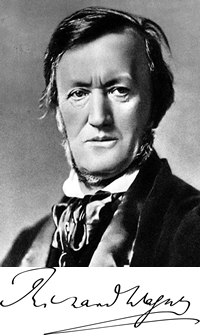 Once you’ve played Wagner, you’re never the same. In the following articles, Local 802 musicians reflect on what Wagner means to them, as we celebrate the great composer’s 200th birthday this year.
Once you’ve played Wagner, you’re never the same. In the following articles, Local 802 musicians reflect on what Wagner means to them, as we celebrate the great composer’s 200th birthday this year.
‘THE ARTWORK OF THE FUTURE’
by Steve Norrell
chiefbone1@aol.com
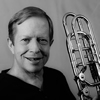
Steve Norell
Having had the opportunity to play Wagner’s operas at the Metropolitan Opera is the fulfillment of a lifelong dream. My appreciation has only grown over the years, as I’ve been privileged to play most of this repertoire many times. On the back of the last page of the first trumpet part of “Die Walküre,” there is a list of who conducted the early year performances. Gustav Mahler was listed as conducting the 1907-08 season!
In 1849, Wagner wrote an article entitled “The Artwork of the Future” in which he described a vision of opera as “Gesamtkunstwerk” (“total work of art”). The various arts such as music, song, dance, poetry, visual arts and stagecraft would be unified. Wagner had his own opera house built, the Bayreuth Festspielhaus, which embodied many novel design features. Performances there were the first to have the concert space dark except for the stage. Only the front of the orchestra pit was visible to the audience as most of the pit went down under the stage with the sound coming through grates above. This made the balance much easier for soloists in the loud tutti sections, but very loud and hot for musicians in the pit. Wagner’s masterpiece “Der Ring des Nibelungen” (commonly known as the Ring Cycle) was first performed here. The Ring Cycle consists of one story spread over four different operas: “Das Rheingold,” “Die Walküre,” “Siegfried” and “Götterdämmerung.” The complete Ring Cycle lasts approximately 18 hours – without intermissions.
Whereas the Ring Cycle must be considered one of the ultimate music dramas, I would consider other Wagner works to be somewhat more vocally lyric. “Die Mestersinger” is his only comic work and the second act is sheer comic genius. Hearing Johan Botha sing the prize song from the third act is one of the most beautiful things I’ve ever heard. “Tristan and Isolde” (which was written between the second and third acts of “Siegfried”) is the ultimate love story where Wagner’s chromatic writing challenges unresolved tonality. Early Wagner works such as “The Flying Dutchman,” “Lohengrin” and “Tannhäuser” seem to me to be somewhat fresher in style, and every “Parsifal” performance is a moving experience for me.
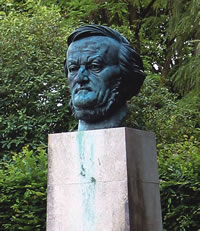
Sculpture of Wagner on the grounds of the Festspielhaus in Bayreuth, Germany. Photo courtesy: Itig Journal
Wagner writes for the full chorus magnificently in all his operas. (In the Ring Cycle, the chorus only enters in “Götterdämmerung.”) His writing for all orchestral instruments challenges their limitations and he invents other instruments to satisfy his musical needs. Even though Wagner is known for loud intensity, I’m always amazed by the transparency of the most delicate moments. Often times a delicate chorale doesn’t have a voice doubled and if a voice doesn’t speak, the harmony is changed.
My first Ring performances were with Erich Leinsdorf, who was also conducting “Die Frau ohne Schatten” by Strauss that season. I remember that Maestro Leinsdorf commented on the difference in performing works by the two composers. Sometimes the virtuosic wave of a fast technical Strauss passage will create the composer’s desired result without every note being perfect. Wagner is more literal and in that way more demanding.
What a pleasure it is listening to my colleagues play their solos across the orchestra pit, but the greatest strength of our orchestra is the depth of our string section. What a sound! These musicians have the greatest challenge in playing this repertoire. It is not just the technical challenge of mastering so many notes, but the physical endurance of playing nonstop for such a long period of time. With two performances on Saturdays, a string player’s nightmare is a doubleheader consisting of a long Wagner followed by a Mozart that requires almost nonstop playing.
While the Met’s supertitles (which have been used for about 20 years) make many operas more accessible than they have ever been, audiences at Met performances will often be highly influenced by the language that’s being sung. If you go into the lobby of the auditorium during the Wagner intermission, it’s not unusual to hear mostly German. For someone who has not previously attended an opera, I would recommend something more accessible like “La Bohème” or “The Magic Flute.” Save the Wagner until you know what you’re getting into.
At the end of the 1988-89 Met season, we played the Otto Schenk production of the entire Ring within one week, which was the first time it had been done at the Met in 100 years. Tickets were sold for complete cycles and you saw the same faces in the same seats as we worked through the Cycle. The applause for the orchestra increased over the course of the week and by the Saturday night “Götterdämmerung” finale, the audience cheering for the orchestra seemed like what one would encounter in a wild athletic event. This is a memory that I will carry with me always.
Steve Norrell plays bass trombone with the Metropolitan Opera Orchestra.
PLAYING IN WAGNER’S WORLD
Erik Ralske
eralske@aol.com
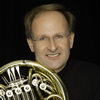
Erik Ralske
Three years ago, I began a new job as principal horn of the Met Opera Orchestra. Up until then, I had spent my entire career as an orchestral player, including 17 seasons with the New York Philharmonic. Symphony orchestra players usually only dine on small appetizers of Wagner – four or five overtures and a few opera excerpts. These are delicious and satisfying masterpieces for sure, but they’re never the experience of a full Wagnerian meal.
In college, we were all taught about Wagner the revolutionary, who changed the world of opera with his new concept of “Gesamtkunstwerk” (“total art work”) and who changed the world of music by virtually ending tonality with his never-resolving “Tristan chord.” But until I began to play these mammoth works in their entirety, I’m not sure I appreciated how Wagner really stands alone as a creative force in the late 19th century.
Appreciating Wagner requires total immersion, which is how Wagner intended his works to be experienced. Rather than attending a lengthy performance after an equally lengthy day at the office as audiences currently do, he wanted his audiences to set aside a period of time to attend a festival of performances, much as the ancient Greeks presented festivals for their performing arts.
My immersion into the world of Wagner began in my first season (2010-2011), when the Met introduced the new Robert Lepage productions of the first two Ring operas – “Das Rheingold” and “Die Walküre.” Since then, we introduced the final two operas of the Ring – “Siegfried” and “Götterdämmerung” – with a half-dozen performances of each. Ultimately, we’ve presented seven complete Ring cycles since the spring of 2012. By luck, my debut at the Met was “Rheingold” with Maestro James Levine conducting – definitely a performance I’ll never forget. I remember thinking at the time what a marathon the piece is! While it is a bit over two and a half hours without intermission and is considered the longest single stretch of unbroken music in the Western world, I hadn’t yet played any of the other three Ring operas, which log in at over five hours each. (I learned an important lesson during the live HD performance of “Rheingold” in my first season about performing any Wagner opera: never over-hydrate before starting!)
Luckily, the mental endurance needed to focus for so many hours comes easily when you are surrounded by a stellar cast and a brilliant and experienced orchestra, all led by a conductor who so clearly understands every note of the piece. On top of that, I simply find the world of Wagner’s music to be so intoxicating. For me, it’s not just the incredible range of expression, drama and originality within these monumental works that moves me. As a horn player in the world of Wagner, you have no choice but to be focused because you’re just so busy and challenged most of the time.
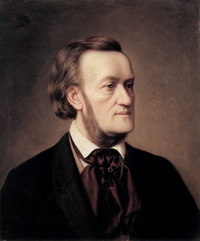
An 1862 portrait of Wagner by Cäsar Willich (1825–1886)
Wagner’s affinity for the horn – and his incredible understanding of the potential of it – is probably only matched by Brahms and Mahler. It seems that no matter what emotion he’s trying to express or what kind of sonic atmosphere he’s painting, he so often reaches for the timbre of the horn. In doing so, he not only added to our rich repertoire, but also pushed beyond the boundaries of how most composers utilized the horn.
By way of example, most players consider the Mount Everest of horn excerpts to be “Siegfried’s Horn Call” from Act 2 of “Siegfried.” I can’t think of any other orchestral work or opera where everyone stops, while the unaccompanied, offstage solo horn takes over for two minutes. In my uninitiated opera days, I got very used to pacing this two-minute solo on my own. What I learned in a dozen performances of this solo is to be ready for anything as far as pacing goes: you have to follow the tenor who is miming it onstage by watching an all-too-often tiny monitor. The other lesson is that casts change from performance to performance, so you don’t always have the same Siegfried leading you each night.
Along those lines, a more significant change came when Maestro Levine injured his back in 2011 and had to bow out of the second half of the Ring presentation. On short notice, Fabio Luisi took over to finish the rest of the Ring performances, leading very different, but equally committed interpretations. As he could not cover all of Levine’s performance dates, assistant conductor Derrick Inouye bravely conducted one performance of “Die Walküre” and “Siegfried” – without an orchestra rehearsal. It’s never a dull moment in the world of opera!
Wagner not only expanded the role of the horn in his operas, but also the role of horn players themselves, by including the Wagner Tuba in his orchestrations. He intended the unique sound of this instrument to bridge the perceived tonal gap in the brass family between the brighter trombone timbre and the less direct horn sound. As they have the same range as a horn, Wagner Tubas are played by horn players. His Ring operas are scored for eight horns in the pit, with four doubling on Wagner Tubas. He spent years trying to find the right sound in a world where brass instruments were not standardized and still evolving. He visited the instrument maker, Adolphe Sax, in Paris and thought the “saxhorn” (a marching instrument) was the right instrument. Later, he decided to commission another maker to design a similar instrument, which came to be known as the Wagner Tuba.
The first time we hear the Wagner Tubas is in the Ring cycle, in “Rheingold,” playing the motif of the golden castle of the gods, Valhalla. It has been a great pleasure to hear them so expertly played over the course of these Ring cycles by my horn colleagues Javier Gandara, Brad Gemeinhart, Michelle Baker, Scott Brubaker, Barbara Joestlein-Currie, Anne Scharer, Julie Pilant and substitute players Tony Cecere and Stewart Rose. These same expert players double on horn throughout the Ring as well.
It would be unwise and probably impossible for one person to play first horn and the main offstage solos on all the Ring operas during a cycle at the Met. Last year we had Britten’s “Billy Budd,” Janacek’s “The Makropolis Case” and several standard operas to play on the off nights. This year, Handel’s “Giulio Cesare,” Poulenc’s “Dialogues des Carmelites” and several repertory works were woven into the Ring schedule. Thankfully, I get to share the principal duties with Joe Anderer, a wonderful hornist and colleague. We tend to divide each cycle roughly in half and still it’s a battle to stay fresh and healthy during the run, especially since we still do seven performances a week during the Ring cycles, with other challenging repertoire on the off nights. This is not an unusual arrangement at most major opera houses.
My newfound passion for Wagner stems not only from the Ring experiences at the Met, but also from a series of awe-inspiring performances this past winter of “Parsifal” led by Danielle Gatti. This religious work was Wagner’s last. The holy and reverential atmosphere easily sweeps both audience and performers into meditative state, with over five hours of mostly gentle, transparent lyricism. One cannot resist being deeply affected by the profound beauty of this masterpiece. For me, it’s just one of the reasons that I don’t miss my old life onstage. Luckily, I won this job in time for the 200th anniversary of Wagner’s birth. Happy birthday, Wagner!
Erik Ralske is the principal horn of the Metropolitan Opera Orchestra.
ONE ACT DOWN, FOUR HOURS TO GO
Perspectives from the pit of Wagner’s ring cycle
Daivd Krauss
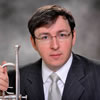
David Krauss
Performing Richard Wagner’s “Der Ring des Nibelungen” is a unique experience. Fanatics fly in from all over the world to settle into the Metropolitan opera house for nearly a week to hear “Das Rheingold,” “Die Walküre,” “Siegfried” and “Götterdämmerung.” Night after night, you tend to recognize familiar faces sitting in the audience. There’s the guy in the tuxedo wearing a horned Brünnhilde helmet with the “Aren’t I clever?” look on his face, or the young couple who came all the way down from their seats high up in the family circle at intermission just to get a close-up look at an actual Wagner tuba. As for us in the pit, the daily schedule shifts to make room for a five- or six-hour performance. Dinners at home become shortened or skipped altogether because of early curtain times, and time stretches so that a two-hour act is normal. Between rehearsals and four complete performance cycles, everyone at the opera house is immersed in the Ring for eight straight weeks.
When I was a kid, Wagner’s music from the Ring had the usual connotations. Elmer Fudd singing “Kill the wabbit,” the soundtracks to “Excalibur” and “Apocalypse Now,” and the vague notion that as a Jew, Wagner’s music was off limits and somewhat akin to the forbidden ham sandwich. My first true exposure to it was when I was a student at Juilliard and Jim Pandolfi, former third trumpet at the Met, got me a last-minute ticket to see “Götterdämmerung” (standing room only to a six-hour opera). This would be a vastly different experience from sneaking into the New York Philharmonic to hear whatever the big piece was after intermission. I don’t remember who sang that night and I vaguely remember the production, but I do remember that Mark Gould, Julie Landsman and David Langlitz were leading the brass section. From the opening notes to the final immolation scene, the sounds floating up from the pit made the hours fly by for me.
The music from the Ring is as rich as the story that unfolds throughout the four operas. Wagner musically represents the gods, giants, dwarfs, mermaids, and generations of heroes and lovers that make up his story through the use of leitmotifs. They musically denote an action, object, emotion, character, place or other subject mentioned in the text or presented onstage. Having done away with the traditional recitative/aria format, Wagner adopted a new “throughcomposed” style where there were no breaks at all in the music. On top of that, Wagner’s instrumental writing for the brass section was revolutionary. The golden ring that the character Alberich guards glimmers with the “Rheingold” motif played by the solo trumpet (Figure 1). Siegmund’s sword does not appear on the stage or in the text without the trumpet playing its motif (Figure 2).

In “The Perfect Wagnerite” by George Bernard Shaw, he explains: “To be able to follow the music of The Ring, all that is necessary is to become familiar enough with the brief musical phrases out of which it is built to recognize them and attach a certain definite significance to them, exactly as any ordinary Englishman recognizes and attaches a definite significance to the opening bars of ‘God Save the King.’ There is no difficulty here: every soldier is expected to learn and distinguish between different bugle calls and trumpet calls; and anyone who can do this can learn and distinguish between the representative themes or ‘leading motives’ (Leitmotifs) of The Ring.”
Indeed, the entire story can be pieced together by following the trumpet part alone. Here are some more examples of Wagner’s leitmotifs as they appear in the first trumpet part:
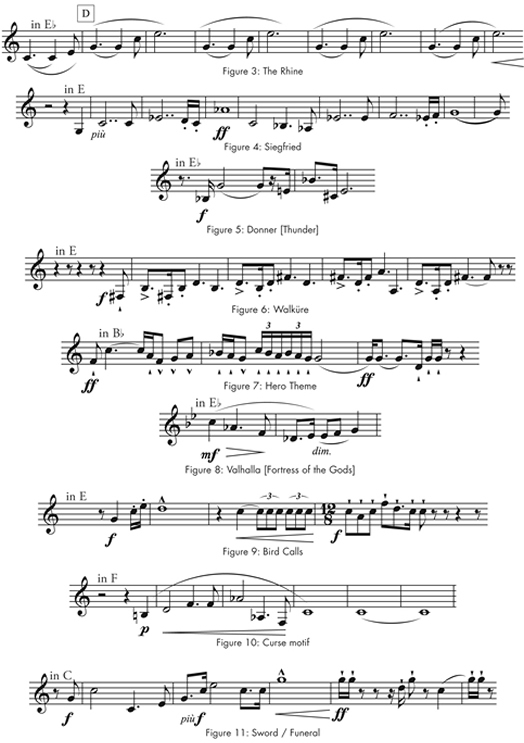
The leitmotifs themselves are short and simple to play when isolated, but combined with the dramatic element and the time associated with it, new challenges arrive. For example, the first trumpet part to “Die Walküre” opens with two lines of music followed by a 45-minute tacet. During the interim, the plot unfolds onstage followed by a crucial trumpet solo motive. Fleeing for his life, Siegmund seeks refuge in a house belonging to Sieglinde and Hunding. Hunding happens to be one of Siegmund’s pursuers and tells Siegmund that when he returns in the morning the two of them will cross swords. Once alone with Sieglinde, Siegmund laments his misfortune, recalling his father’s promise that he would find a sword in direst need. Siegmund and Sieglinde fall in love, discover they are twins, and the audience realizes that their father (Wotan) has brought the twins together to achieve his ultimate plan of attaining the ring and ultimate power. It’s basically the entire plot of all three original “Star Wars” movies together in one scene. At the climax of the act, Siegmund calls out the human name of his father and discovers a sword plunged into a tree. It is at this moment where the trumpet plays the sword motive. With 45 minutes to stare at seven simple notes, many things can (and often do) go through my head. “My horn is cold. I should push in. Did I push in too much? My head hurts. How do you get the water out of a rotary trumpet anyway? Remember that time the second valve stuck? What key am I in?” As the music slowly draws closer to the solo, the intensity builds and string tremolos rage as he cries out “Walse! Walse! Where is your sword?” – then it’s my turn to play.
It’s easy for me to get paralyzed with negativity (a trait I possess in abundance). The key is to focus on the variables within my control. I try to push all the worrisome thoughts out of my head by relaxing and maintaining slow deep breaths. I constantly have to fight the urge to fidget with my horn and focus on counting bars and listening to the music. If I am in shape and prepared, everything else will take care of itself.
In addition to using the brass section as a thematic vehicle, Wagner re-invented the instruments themselves as well as the theatre they were played in. The Bayreuth Festspielhaus was designed with many theatrical advantages in mind. One of them was the unique placement of the orchestra. In this excerpt, Shaw shares his critique of Ring performances at Bayreuth: “Bayreuth performances will deserve their reputation. The band is placed out of sight of the audience, with the more formidable instruments beneath the stage, so that the singers have not to sing through the brass. The effect is quite perfect.”
The Wagner tuba was designed to fill the gap in sound between the trombones and the French horns. Similarly, the bass trumpet and contrabass trombone were modified to bridge the voids from trumpet all the way down to the tuba. Since Wagner went through such thorough efforts to create a homogeneous sound in the brass section, it is important for us as trumpet players to examine our role in the context of what Wagner thought an opera orchestra should sound like with great care.
In 2007, I was driving up to Boston from Manhattan to visit friends. Just past Hartford, there is a New York-style deli just off I-84. While I was waiting in line for my name to be called after placing my order for pastrami on rye to go, I heard the guy behind the counter yell “Daniel B… Daniel B…” Standing right in from of me in line for pastrami was Daniel Barenboim. I introduced myself and we talked about how he was coming to the Met to conduct “Tristan und Isolde” during the 2008-2009 season. He asked right away, “Will you use German trumpets?” Politely, I explained that traditionally we only use them on Mozart operas and “Fidelio.” “But what about ‘Parsifal’? Why don’t you use them for ‘Parsifal’?” he questioned. “Because I like to hit some of the notes,” I replied. A smile came and went on his face and then he rather sternly said, “But when I come for ‘Tristan,’ you will use them, yes?” My reply, “Yes, Maestro, for you we’ll play them.”
I always thought the use of rotary trumpets was mostly for show. Conductors see them and think that they hear a different sound, a “German” sound. For the most part, my rotary trumpet stayed in my locker except for Mozart, Beethoven and Brahms. Everything else was naturally played on my piston instruments. The following season when Lorin Maazel came to conduct “Die Walküre,” I figured this would be a good time to get the horns out before “Tristan” with Barenboim. After the initial awkwardness of playing difficult music on a foreign instrument, the advantages became apparent. The sound stays warm and covered from pianissimo dynamics to forte, and the clarity of attacks is obscured. The absence of brilliance (at the required dynamic levels) makes blending with the horn section effortless and natural. Like the French horn, from forte and above, the tone lights up quickly and at fortissimo in the higher register, it’s possible to play with a white-hot sound. In retrospect, when playing a piston trumpet, I played softer than Wagner’s printed dynamics most of the time in order to achieve the right balance. The rotary trumpet’s inherent tonal tendencies are a much better match for playing Wagner.
No matter what instrument I play and despite any obstacles I may face in performance, the Ring is always an enjoyable experience. Most performances end with a beer or two across the street with colleagues and friends. Since Ring cycles are programmed every three or four years, each time we start it feels fresh and by the end of it, I can’t stomach one more note.
Like any great work of art, it changes relative to your own experience. The last page of the Met’s first trumpet part to “Die Walküre” has handwritten lists of performances started by former principal trumpeters Jacob Hager, Edwin Franko Goldman and Isidor Blank. The list documents performances of “Walküre” going back to 1901 with such legendary conductors as Gustav Mahler, Arthur Bodansky and Arturo Toscanini. I felt a great sense of history when I signed my name at the bottom of the page after my first performance in 2002 (led by James Levine). When Goldman played this very part just 18 years after Wagner’s death, the profound nature of playing his music as contemporary must have had a tremendous impact on him. Even more than a century later, “Der Ring des Nibelungen” stands alone as the most ambitious and most profound work ever created for the theatre. Though the trumpet part is of relatively small consequence in the epic scale of the work, its role is vital to the story and its voice is a prominent color in the score. From my vantage point in the pit, it’s wonderful to see the impact of the trumpet part both on the stage and in the audience.
David Krauss is principal trumpet of the Metropolitan Opera Orchestra. This article first appeared in the June 2009 issue of the International Trumpet Guild Journal and is reprinted here with the permission of ITG. Thanks to Robert Sutherland, chief librarian of the Metropolitan Opera, with formatting the leitmotifs. For more on the letimotifs, see www.bitly.com/leitmotifs.
